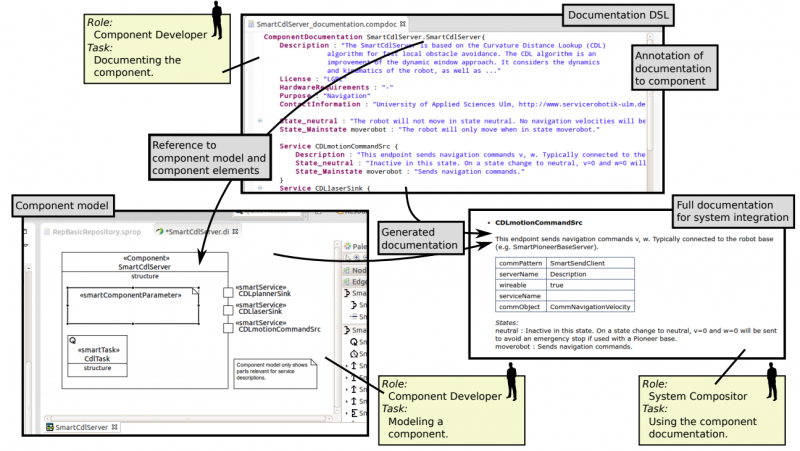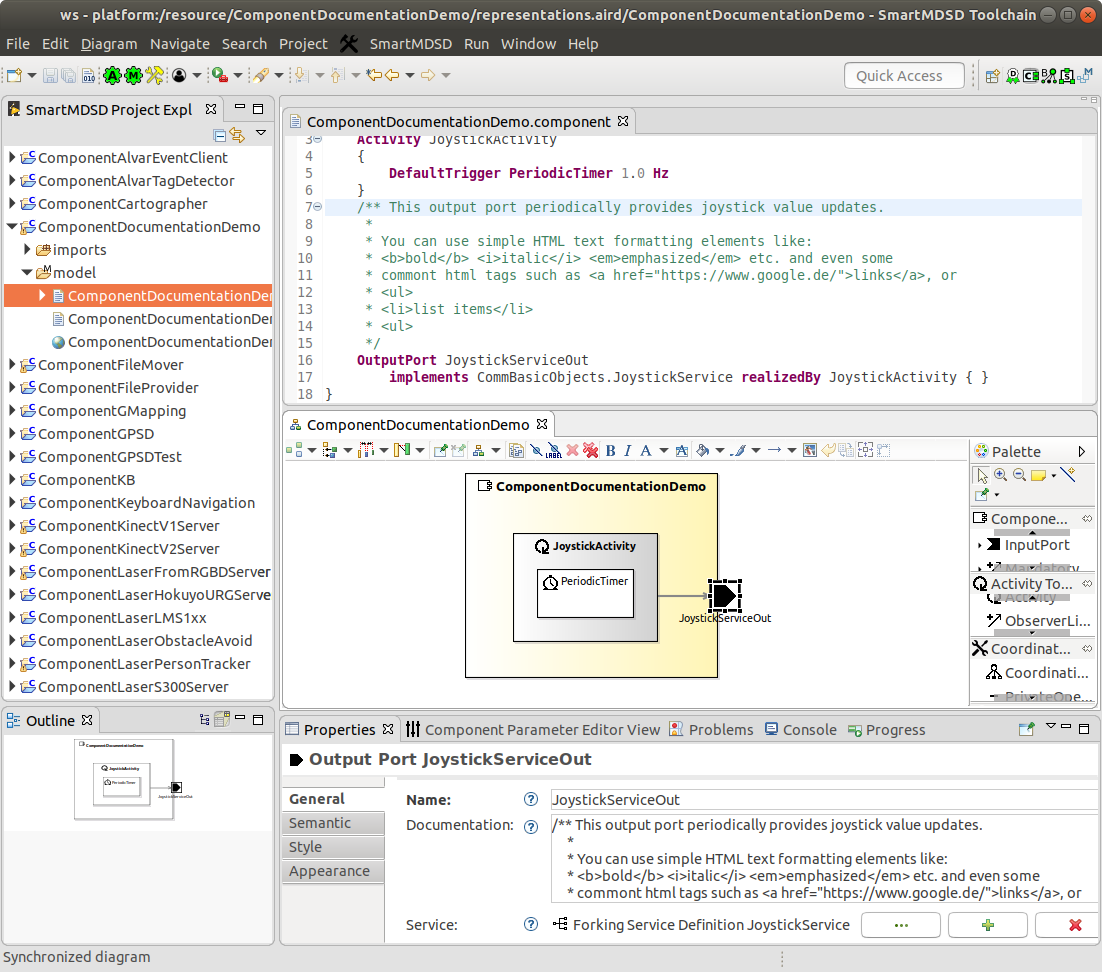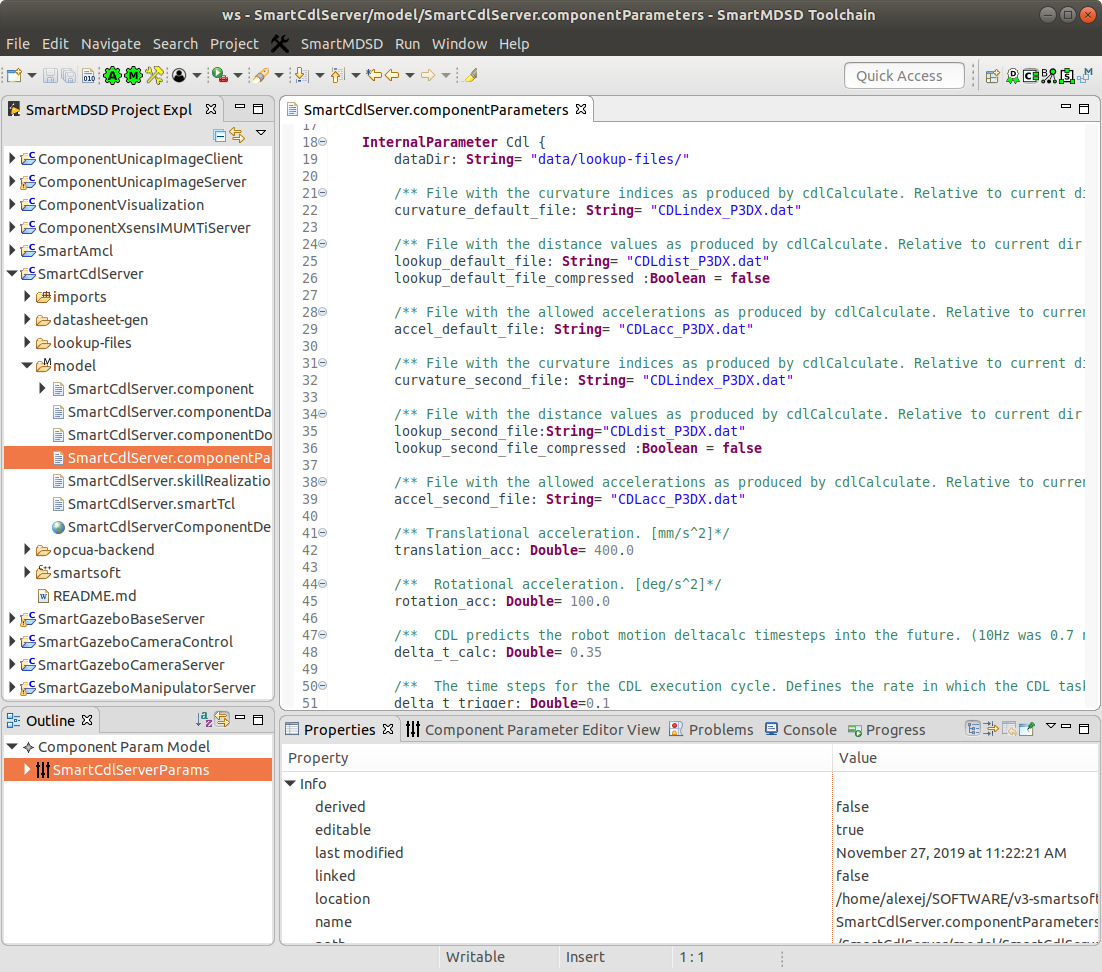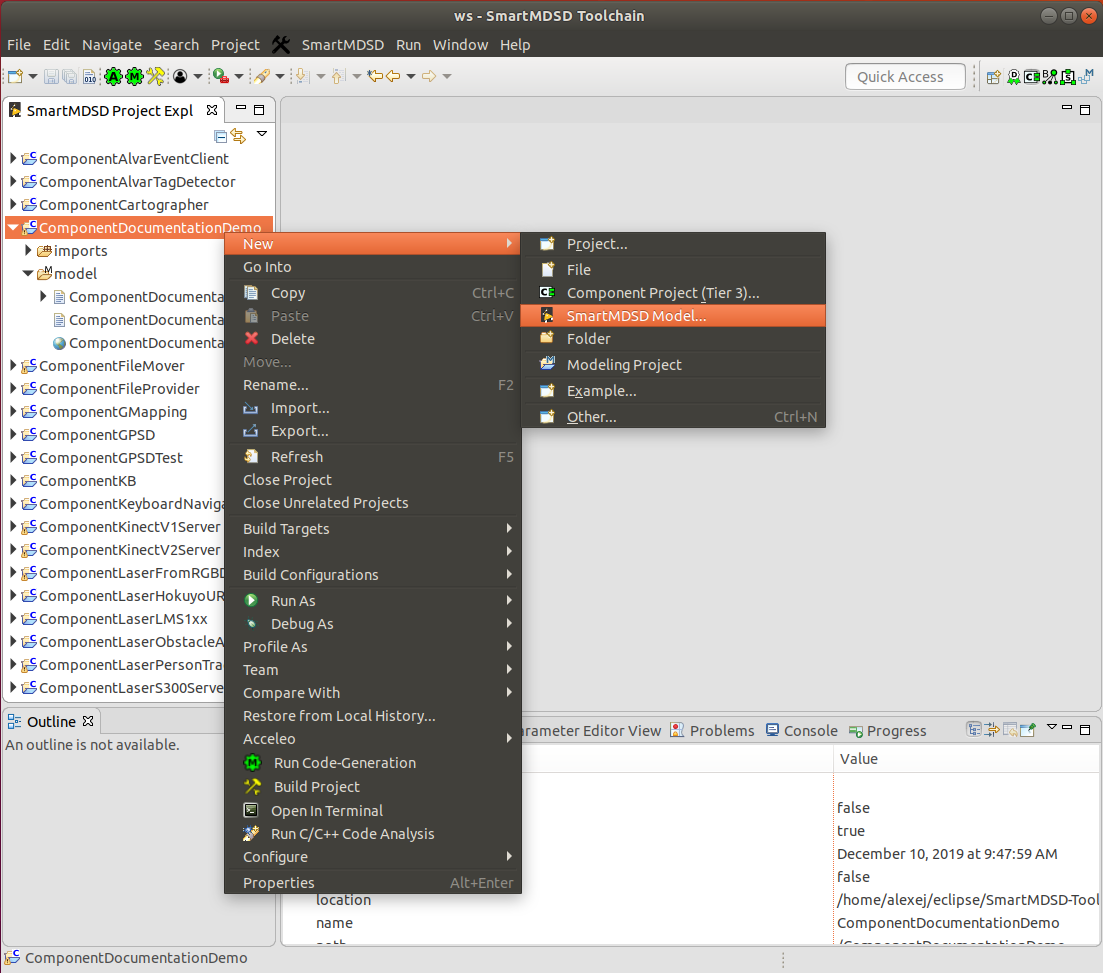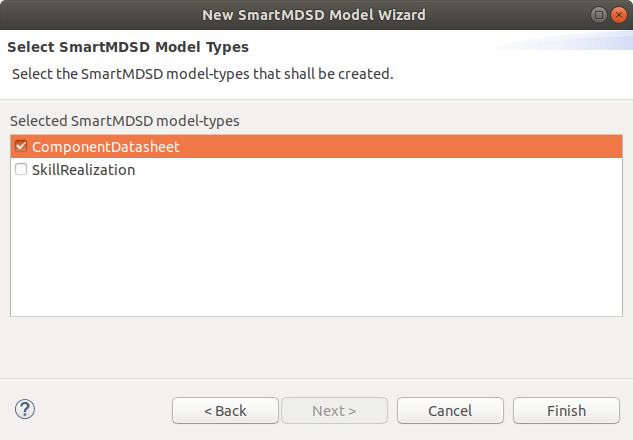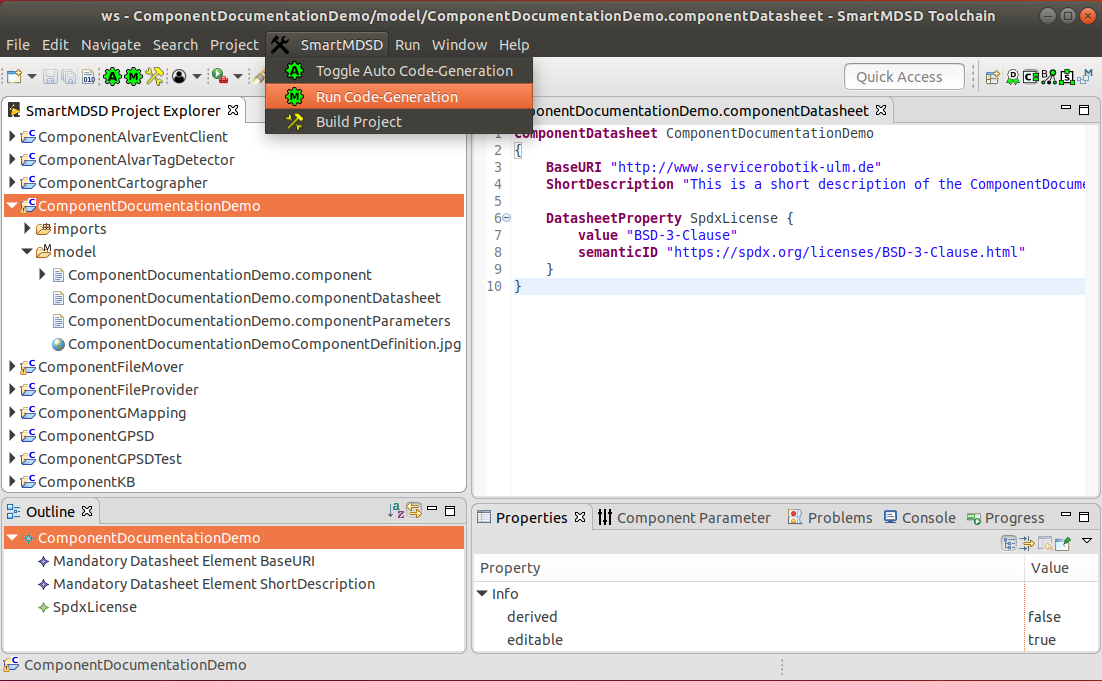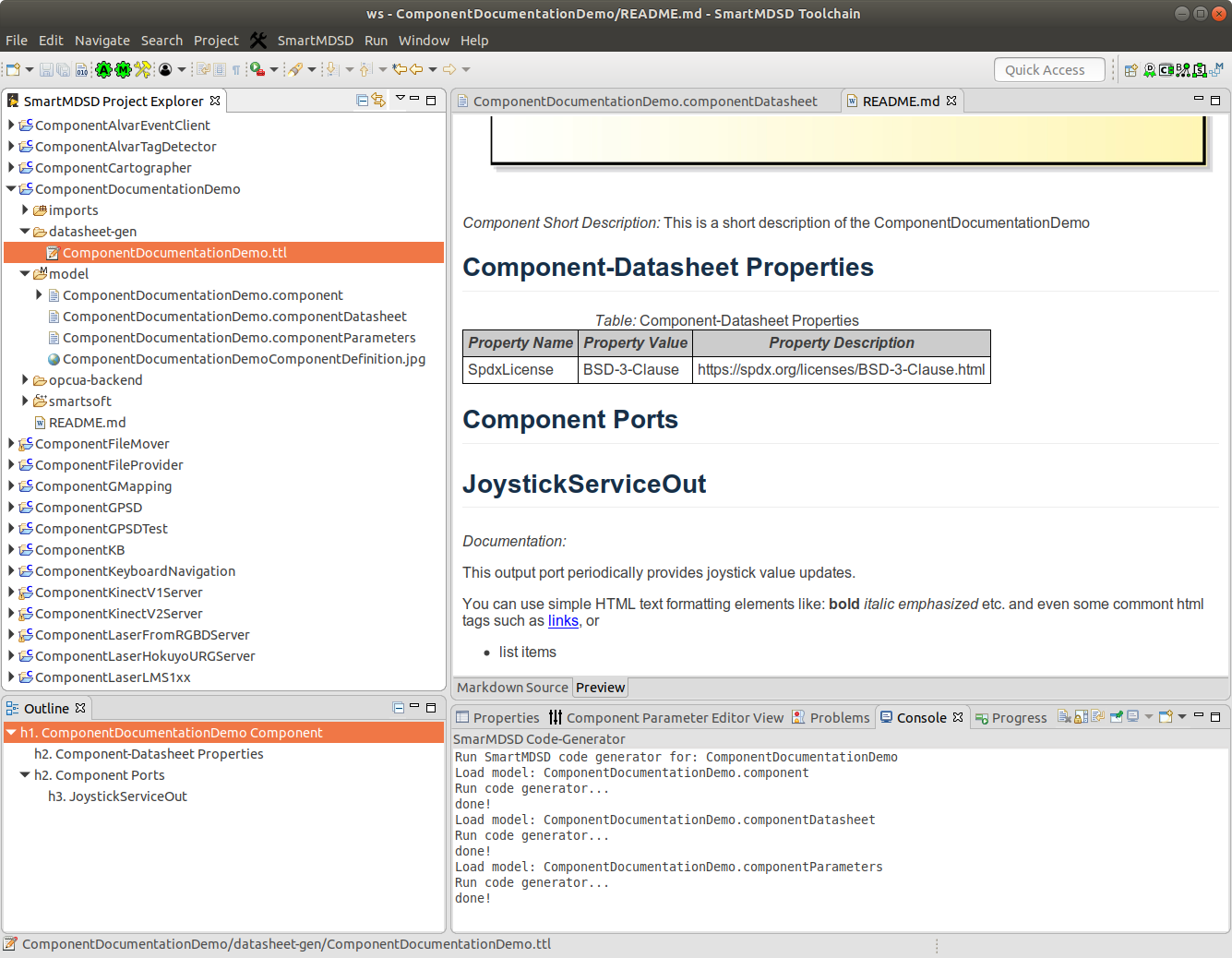Table of Contents
Annotation and Documentation via the Digital Datatsheet
A digital data sheet contains different sections; at least a technical section and annotations section for humans. The SmartMDSD Toolchain supports the technical digital data sheet via its models. Its support via annotations is currently distributed over several places as this technology is currently in migration.
The concept of annotations via a component documentation model to enrich a software component with descriptions for humans is described in:
- [Stampfer2018] Dennis Stampfer. “Contributions to System Composition using a System Design Process driven by Service Definitions for Service Robotics”. Dissertation, Technische Universität München, München, Germany, 2018. Link
- [Stampfer2016] Dennis Stampfer, Alex Lotz, Matthias Lutz, and Christian Schlegel. “The SmartMDSD Toolchain: An Integrated MDSD Workflow and Integrated Development Environment (IDE) for Robotics Software.” In: Journal of Software Engineering for Robotics (JOSER): Special Issue on Domain-Specific Languages and Models in Robotics (DSLRob) 7.1 (2016). ISSN 2035-3928, pp. 3–19. Link
The concept is illustrated in the figure below [Stampfer2018]: The technical (component) model and the non-technical annotations together provide information for dedicated use-cases. Note that “data sheet model” and “documentation model/DSL” are used as synonyms here. The figure below illustrates the documentation for humans. The RDF example below illustrates the import in a triple-store for semantic search. Another example is the interaction with other tools via the digital data sheet (see the interaction between SmartMDSD Toolchain and Groot).
Documenting the Component Model
Since SmartMDSD Toolchain version 3.12, the overall documentation is split into two main parts, one is the explicit digital datasheet model for non-technical properties (see the next section below) and the other is the implicit annotation of technical models (as described next).
For technical documentation, you don't have to create any new models, but rather directly document your model elements as part of the technical model itself. In order to better distinguish the documentation from the actial model elements and for a most intuitive experience, we have adopted the notion of doxygen-like code comments in our textual models. So in order to document any model element, just add a comment above a specific element. Here we distinguish between two types of comments. One is the multiline comment that looks like this:
At the top in the screenshot you can see the textual representation of the component model and as an example, the ouput port named JoystickServiceOut has a green comment above it. Please note the two asterisks after the slash /**. A comment with two asterisks at the beginning is interpreted as an intentional documentation element, while a regular comment with only one asterisk after the slash /* is interpreted as a regular comment that is entirely ignored by the model interpreter. Regular comments can be used for example to temporarily comment out parts of the model or write any other comments that are not related to the model or documentation. Please also notice, each model element can have zero or exactly one documentation element that must be placed above the element to document, but an arbitrary number of regular comments that can be placed anywhere in the model. Moreover, you can use simple HTML text formatting tags which are interpreted at multiple places for formating the documentation comments. Please further notice that the optional astersisks (at the left side of the comment) are later parsed away for the actual documentation, so you don't have to care about them too much, they mostly serve a cosmetic purpose and are unrelated to the actual documentation.
Next, at the center of the above screenshot, you can see the graphical diagram of the example component model with the selected output port JoystickServiceOut, whose properties are further shown at the botton of the screenshot within the Properties tab. There you can see the same documentation comment and you can even directly modify its contents directly from the Properties tab. Please be aware that you still have to use the doxygen-like syntax with the /** tag as explained for the textual part above. Regardless of from which model editor (graphical or textual) you create the documentation elements, the respective other representation will be automatically synchronized as soon as you save the model.
The doxygen-like documentation capability is not limited to the component model, but is a recurring functionality in many other models as well. For instance, the component parameters can be documented in the same way as shown in the next screenshot:
Here you can see the parameters of the CDL component (as an example) that are documented individually using the same comment-like syntax. As can bee seen not every element strictly has to be documented (although we highly recommend to do so), and you don't have to use multiple lines for documentation, single line comments are fine as well.
Adding further Non-technical Meta-Data Elements to the Component Model
Since SmartMDSD Toolchain version 3.12, the ComponentDatasheet has been refined such that it solely focusses on the non-technical, yet structured documentation and annotation for meta-data elements such as e.g. the used license, the manufacturer and other non-technical attributes (descriptive information, also semantic information). Please notice, that the ComponentDatasheet model now replaces the old Component Documentation model, which is even deactivated since the SmartMDSD Toolchain version 3.12.
You can easily create a new ComponentDatasheet model as follows (see also the following screenshot):
- Select a project in the SmartMDSD Project Explorer window at the left side of the Eclipse window
- Right click on the project and click at the context menu: New ⇒ SmartMDSD Model…
A new popup window will appear where you will see the selected project. Please press the Next button so you should see this window:
Here you should activate the checkbox for the ComponentDatasheet model type and press the Finish button to create the model in your project. If you now check the model folder of your project at the right side in the SmartMDSD Project Explorer, you should now see a new model with the file extension .componentDatasheet:
Also, the component datasheet model will automatically open in the textual model editor as shown at the center of the above screenshot. Here you can add an arbitrary number of further custom DatasheetPropert elements. Each DatasheetProperty requires a name and a value. In addition, a semanticID and a shortDescription can be added. The value can be any string that makes sense in the context of the respective property. The semanticID is used to optionally reference an external specification of the property which can be e.g. an externally defined ontology, or any other taxonomy.
When you have provided all the required properties, you can now trigger the code generation (as shown in the above screenshot). Therefore, select the project within the SmartMDSD Project Explorer for which you want to trigger the code generator, and then use the Eclipse menu SmartMDSD ⇒ Run Code-Generation. This will generate two main outputs as described below.
The code generation for the ComponentDatasheet model will generate two files, one is the Readme.md file that will collect all the technical documentation comments from all related technical models, as well as the non-technical properties from the datasheet model itself. You can vew the contents of the Readme by double clicking at it. Please don't modify the generated Readme.md file manually as all the manual changes will be whiped out the next time the code generation is triggered again. Instead you should provide the respective documentation directly within the models as described in the preceeding sections above and trigger the code generation again to update the Readme file. As a nice side effect, the Readme.md file uses a markdown syntax that is compatible with the Github markdown syntax, so that the readmes are nocely renderred when uploading the projects to Github.
The second output of the ComponentDatasheet model is the .ttl file located in the new datasheet-gen subfolder. This file uses the RDF/TTL syntax for importing in semantic triple-stores. We might add further output formats in the future releases of the SmartMDSD Toolchain.
Please notice, the documentation outputs are only generated if the respective project has a valid ComponentDatasheet model which acts as root model for code generation. This means that while you can (and should) provide technical documentation within technical models as described above, their output in the different datasheet formats will first take effect when you create a datasheet model. After that, you can modify any of the models as needed and the datasheet outputs will collect all the updates of all the models and re-combine them in the collective outputs.
The documentation of the DomainModel and System projects works analogously to the here presented Component documentation, with the only difference of the Datasheet file extensions which are analogously .domainModelsDatasheet and .systemDatasheet.
Free Form Documentation
To describe and document the algorithm that you implemented in a component, component behavior, or anything that is not covered by the above means for documentation, proceed as follows:
- Create a folder “documentation” in your project root
- Place at least a index.md in that folder and put your documentation in markdown into that file
- Feel free to add any figures and further .md files to the documentation/ folder. Make sure to link to them via index.md
